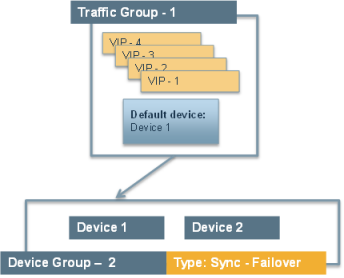Applies To:
Show Versions
BIG-IP AAM
- 14.0.1, 14.0.0
BIG-IP APM
- 14.0.1, 14.0.0
BIG-IP Analytics
- 14.0.1, 14.0.0
BIG-IP Link Controller
- 14.0.1, 14.0.0
BIG-IP LTM
- 14.0.1, 14.0.0
BIG-IP PEM
- 14.0.1, 14.0.0
BIG-IP AFM
- 14.0.1, 14.0.0
BIG-IP DNS
- 14.0.1, 14.0.0
BIG-IP ASM
- 14.0.1, 14.0.0
Creating an Active-Standby Configuration Using the Setup Utility
Overview: Creating a basic active-standby configuration
This implementation describes how to use the Setup utility to configure two new BIG-IP® devices that function as an active-standby pair. An active-standby pair is a pair of BIG-IP devices configured so that one device is actively processing traffic while the other device remains ready to take over if failover occurs. The two devices synchronize their configuration data and can fail over to one another in the event that one of the devices becomes unavailable.
First, you run the Setup utility on each device to configure base network components (that is, a management port, administrative passwords, and the default VLANs and their associated self IP addresses). Continue running it on each device to establish a trust relationship between the two devices, and create a Sync-Failover type of device group that contains two member devices.
After the Setup utility is run on both devices, each device contains the default traffic group that the BIG-IP system automatically created during setup. A traffic group represents a set of configuration objects (such as floating self IP addresses and virtual IP addresses) that process application traffic. This traffic group actively processes traffic on one of the two devices, making that device the active device. When failover occurs, the traffic group becomes active on (that is, floats to) the peer BIG-IP device.
By default, the traffic group contains the floating self IP addresses of the default VLANs. Whenever you create additional configuration objects such as self IP addresses, virtual IP addresses, and SNATs, the system automatically adds these objects to the default traffic group.
Example
In this configuration example, the device group is named Device Group A. This device group contains two BIG-IP devices, named Device 1 and Device 2, and these two devices are peers of one another. The default traffic group, named traffic-group-1, resides on each device.
Device 1 actively processes traffic because traffic-group-1 is in an Active state on that device. Device 2 remains idle until failover occurs because traffic-group-1 is in a Standby state on that device.

Example active-standby configuration
By implementing this configuration, you ensure that:
- Each device has base network components (such as self IPs and VLANs) configured.
- The two devices can synchronize their configuration to one another.
- Failover capability and connection mirroring are enabled on each device.
Task summary
Using the Setup Utility, you can create a basic active-standby configuration containing two BIG-IP devices.
Licensing and provisioning the BIG-IP system
Configuring a device certificate
- Click Import, import a certificate, click Import, and then click Next.
- Verify the displayed information for the certificate and click Next.
Configuring the management port and administrative user accounts
Enabling ConfigSync and high availability
Configuring the internal network
Configuring the external network
Configuring the network for high availability
Configuring a ConfigSync address
Configuring failover and mirroring addresses
Discovering a peer device
You can use the Setup utility to discover a peer device for the purpose of exchanging failover and mirroring information.





